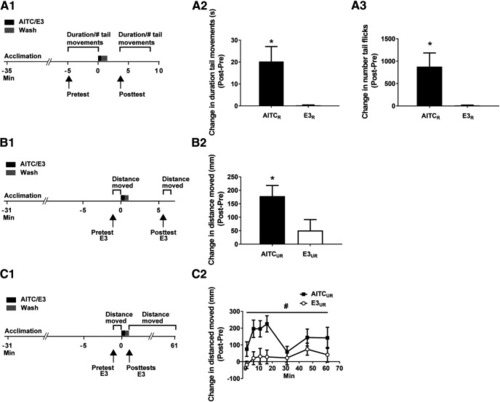
AITC elicits persistently enhanced locomotion in zebrafish larvae. A1, Experimental protocol for tests of sensitization-like enhancement of locomotor activity in semi-restrained larvae. The movement of the larvae, either swimming-like behavior or tail flicks, was sampled during the 5-min period immediately before the onset of AITC/E3 exposure (30 s), as well as during the period 2–7 min after a 1-min washout of the drug/E3. A2, AITC caused an increase in swimming-like tail movements that persisted for ≥5 min. An unpaired t test indicated that fish treated with AITC (AITCR group, n = 12) moved for a longer time after the AITC was washed out than did fish treated with E3 alone (E3R group, n = 12; t(22) = 2.94, p = 0.008). A3, AITC also caused a persistent increase in the number of spontaneous tail flicks. AITC-exposed fish exhibited significantly more tail flicks following washout of the irritant than fish exposed to E3 alone (t(22) = 2.83, p = 0.01). Note that the results presented in A2, A3 are based on the same data. B1, Experimental protocol for testing whether AITC had a persistent effect on locomotion in freely swimming larvae. B2, Distance moved by unrestrained larvae in response to AITC/E3. The total distance moved was measured for the 60 s immediately preceding the onset of a 30-s treatment with AITC/E3 and during the period 4.5–5.5 min after washout (30 s long) of the drug/E3. The change in distance moved by larvae in response to AITC (AITCUR group, n = 10) was significantly greater than that by larvae exposed simply to E3 (E3UR group, n = 10; t(18) = 2.33; p = 0.03). C1, Experimental protocol for determining the persistence of AITC’s enhancement of locomotion in freely swimming larvae. C2, Change in distance moved by larvae in response to AITC/E3 over a 60-min time period. For this purpose, the total distance moved was measured for the 60 s immediately preceding the onset of AITC/E3 treatment (30-s duration) and periodically over 60 min after washout (30 s) of AITC/E3. A repeated-measures, two-way ANOVA failed to find a significant interaction (F(6,108) = 1.50; p = 0.19). However, the main effect for exposure to AITC or E3 was significant (F(1,18) = 7.47; p = 0.01), indicating that the change in distance moved by larvae following delivery of AITC (AITCUR group, n = 10) was significantly greater than that by larvae after exposure to E3 alone (E3UR group, n = 10). A repeated-measures, two-way ANOVA using non-normalized data found a significant interaction (F(7,126) = 2.12; p < 0.05). Probes of this interaction using one-way ANOVAs indicated significant differences at the 6-min (F(1,18) = 8.60, p = 0.009), 11-min (F(1,18) = 9.10, p = 0.007), and 16-min (F(1,18) = 15.09, p = 0.001) tests between the AITCTHIGMO (n = 10) and E3THIGMO (n = 10) groups. This figure shows means ± SEM, with * indicating a significant (p < 0.05) difference between groups and # indicating a significant (p < 0.05) main effect.
|

